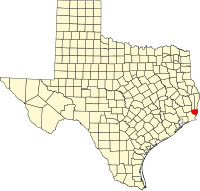Orange County, Texas
| Orange County, Texas | ||
|---|---|---|

The Orange County Courthouse in Orange
|
||
|
||
 Location in the U.S. state of Texas |
||
 Texas's location in the U.S. |
||
| Founded | January 5, 1852 | |
| Named for | Orange fruit | |
| Seat | Orange | |
| Largest city | Orange | |
| Area | ||
| • Total | 380 sq mi (984 km2) | |
| • Land | 334 sq mi (865 km2) | |
| • Water | 46 sq mi (119 km2), 12% | |
| Population | ||
| • (2010) | 81,837 | |
| • Density | 245/sq mi (95/km²) | |
| Congressional district | 36th | |
| Time zone | Central: UTC-6/-5 | |
| Website | www |
|
Orange County is a county in the U.S. state of Texas. As of the 2010 census, its population was 81,837. The county seat is Orange.
Orange County is included in the Beaumont-Port Arthur, TX Metropolitan Statistical Area. It is located in the very southeastern corner of Texas, with a boundary with Louisiana, within the Golden Triangle of Texas.
Orange County was formed in 1852 from portions of Jefferson County. It was named after the orange fruit, the common citrus fruit grown by the early settlers of this County near the mouth of the Sabine River. Due to periodic spells of quite cold winter weather (frosts) in Orange County, it is no longer the home of orange trees and citrus orchards. The production of those fruits in Texas long ago was moved a long way southwest into the Rio Grande Valley, where the weather is almost always warm all winter long. Citrus trees produce their fruit in the wintertime, which makes them especially vulnerable to frost and icy weather.
A similar thing has happened in Florida, where orchards of citrus trees no longer exist in either Citrus County or Orange County because of bad winter freezes in some years. In both Florida and Texas, the citrus agriculture has been moved farther south in search of milder winters, and away from the periodic frosts.
...
Wikipedia

